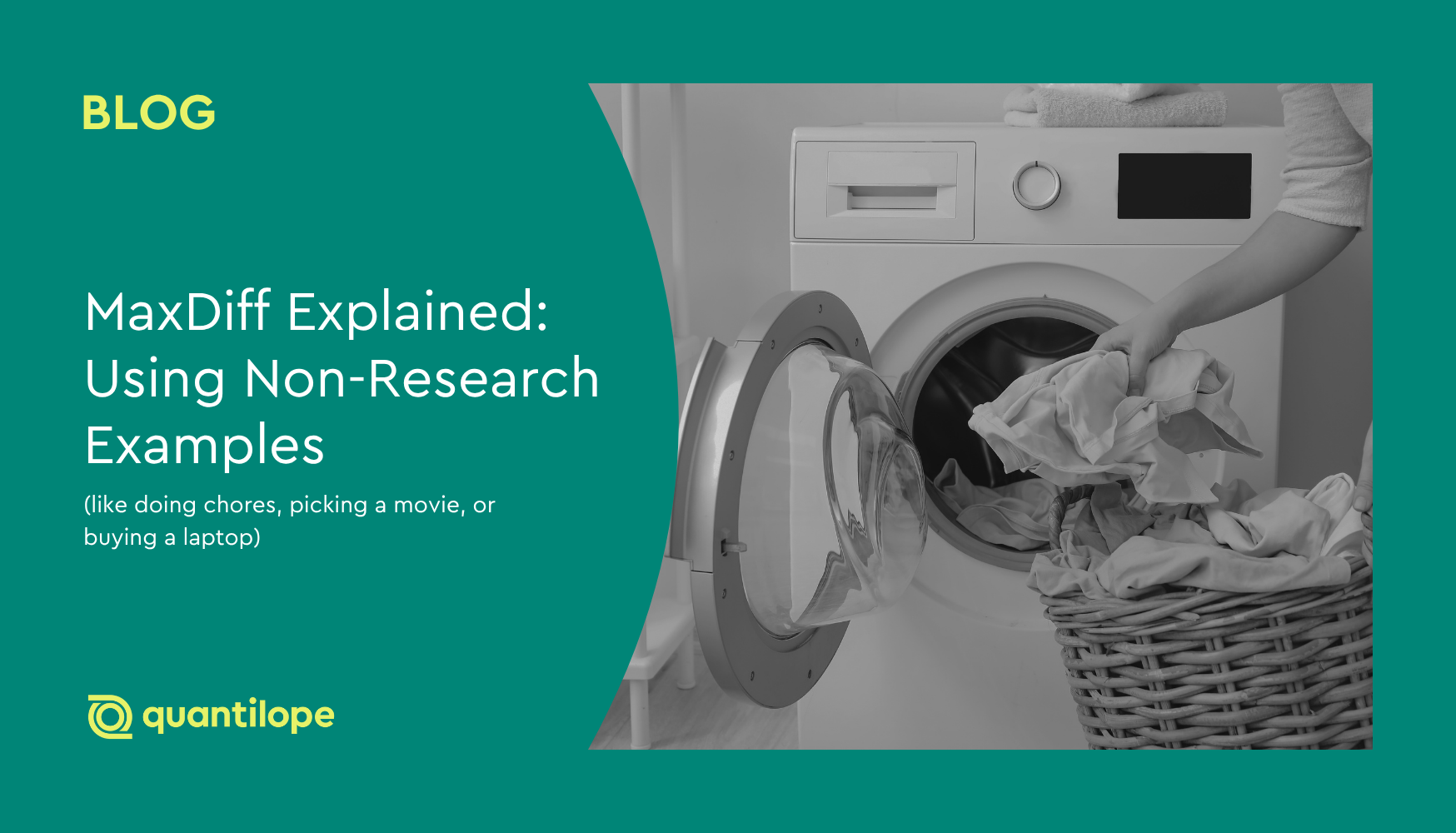Types of consumer surveys
When it comes to running consumer surveys, there are a few different avenues to consider. Today, most consumer surveys are done digitally, given how accessible smartphones and home technology devices are. However, other types of surveys are worth considering, depending on what makes the most sense for your resources and time constraints.
-
Online surveys: Many research agencies send out online surveys through panel providers which pre-vet respondents based on their demographics and consumer behaviors. This makes it cost-effective and efficient for brands to gather survey responses from niche audiences, quickly. Other means of distribution include email, social media (like LinkedIn), or embedding a survey on a website.
-
In-person surveys: These are face-to-face interviews conducted in public places, interview centers, or at respondents' homes, allowing for deeper insights and observation of non-verbal cues (like facial expressions and body language).
-
Focus Groups: Similar to in-person surveys which are usually one-on-one, focus groups gather a small group of respondents to discuss a specific topic. This approach provides qualitative data and in-depth insights into consumer opinions and attitudes, with respondents being able to bounce ideas off one another.
-
Telephone surveys: This type of survey research is conducted over the phone, offering a balance between cost-effectiveness and personal interaction, but may lack a level of detail that you’d get from an online survey or in-person survey/focus group.
-
Mail surveys: These are surveys sent via postal mail, often used to reach specific demographic groups but are more likely to struggle with response rates.
Back to Table of Contents
Examples of consumer survey questions
Within a consumer survey, brands can ask any questions needed to support their research objectives. Some commonly asked questions in consumer surveys include:
-
Demographic questions: Questions that identify consumers and are often used to screen for the right participants and to use in data cuts during analysis. These are questions like "What is your age range?" or "What is your household income?"
-
Product usage questions: Questions that explore how consumers are using or interacting with a product or service, such as "How often do you use our product?" or "What features do you find most valuable?"
-
Customer satisfaction questions: Questions that uncover how well your brand is doing at satisfying its customers and meeting their needs, such as "How satisfied are you with your recent purchase?" or "How likely are you to recommend our product to a friend?"
-
Open-ended questions: Questions that dive deeper into consumer feedback through more in-depth responses that consumers will type out or speak in-depth on, such as "What are your thoughts on our brand?" or "How can we improve our service?"
These are just a few examples of common consumer survey questions. Brands can get as detailed as they need, though they should keep in mind the overall flow and length of their survey to keep respondents engaged.
Back to Table of Contents
Consumer survey methods
Within a consumer survey, brands can incorporate advanced survey methods along with standard usage and attitude (U&A) questions. Advanced survey methods gather more in-depth feedback, often exploring the ‘why’ of consumer insights rather than just the ‘what’.
Below are a few examples of advanced methodologies to consider adding into your survey. For a more comprehensive list, check out quantilope’s largest suite of methodologies.
-
MaxDiff (Maximum Difference Scaling)
MaxDiff is a method used to determine preferences and priorities among a set of items. Respondents are presented with small subsets of items and asked to choose the most and least preferred options within each subset. Within a MaxDiff, the set of features will rotate so that respondents are continuously choosing their most and least preferred option out of a different set of alternatives, to really understand the relative importance of different attributes or features.
How to use a MaxDiff for consumer surveys:
-
- Product development: Identify the most preferred product features or concepts by asking respondents to choose the best and worst from a set of options.
- Brand positioning: Understand which brand attributes are most important to consumers by presenting them with different brand value propositions.
- Consumer or employee satisfaction: Ask respondents about various aspects of your brand/company that are most and least influential to their satisfaction.
-
Choice-based Conjoint
Choice-based Conjoint (CBC) is a technique used to understand how consumers make trade-offs between different product attributes. Respondents are presented with multiple product profiles, each with varying features, and asked to choose their preferred option overall. This helps brands understand which specific features are most important to consumers to build a final product that’s highly appealing.
How to use a CBC for consumer surveys:
-
-
New product development: Simulate different product configurations and identify the combination of features that is most appealing to consumers.
-
Pricing strategy: Understand how price changes affect consumer choices and determine the optimal price-value relationship.
-
Marketing and brand positioning: Identify the most effective marketing messages and advertising claims by testing different combinations of features, benefits, and value propositions.
-
-
TURF Analysis (Total Unduplicated Reach and Frequency)
TURF analysis is used to determine the optimal combination of products, services, or marketing messages to reach the largest possible audience. It helps identify which offerings will appeal to the widest range of consumers while minimizing overlap (i.e. reaching the same consumer twice for different features rather than two new consumers for two different features).
How to use TURF for consumer surveys:
-
-
Product line optimization: Determine the best combination of products to offer to maximize market share.
-
Marketing campaign planning: Identify the most effective mix of marketing channels and messages to reach a target audience.
-
Content strategy: Determine the optimal mix of content topics to attract and engage the largest audience.
-
-
Segmentation
Segmentation is the process of dividing a market into distinct groups of consumers with similar needs, characteristics, or behaviors. This allows businesses to effectively tailor their products, services, and marketing efforts to specific groups.
How to use segmentation for consumer surveys:
-
-
Demographic segmentation: Divide consumers based on age, gender, income, location, etc.
-
Psychographic segmentation: Group consumers based on lifestyle, values, personality traits, etc.
-
Need-based segmentation: Segment consumers based on their product wants and needs
-
-
Implicit Association Test
An Implicit Association Test is a psychological test used to measure unconscious biases or associations. There are two versions of an Implicit Association Test - a Single Implicit Association Test (SIAT) which assesses the strength of subconscious associations for a single brand, product, or category, and a Multiple Implicit Association Test (MIAT) which assesses the strength of associations for a multiple brands, products, or categories.
How to use Implicit Testing for consumer surveys:
-
- Brand perception: Measure unconscious associations consumers have with different brands.
- Advertising effectiveness: Assess the implicit impact of advertising on consumer attitudes.
- Product design: Understand how consumers unconsciously react to different product designs or aesthetics.
By using (or even combining) these methods, businesses can gain a comprehensive understanding of consumer preferences, behaviors, and motivations. These advanced method insights can be used to make informed decisions about product development, marketing strategies, and overall business strategy.
Back to Table of Contents
How to create a consumer survey
Creating an effective consumer survey takes some careful thought and planning to ensure you gather valuable data. Below are some steps to set yourself up for success when creating a consumer survey.
1. Define your survey objectives
Start by clearly outlining the goals of your consumer survey. What do you want to learn from your target audience? How will these insights inform your business decisions? Your objectives should drive the creation of survey questions so that you ensure you stay focused on your overall research goal.
2. Craft unbiased questions
Next, craft questions that will answer your survey objectives. Use clear and concise language, avoiding jargon or leading questions that could influence or bias responses. Mix up your question types for a smooth and engaging respondent experience. Combine closed-ended questions (multiple choice, rating scales) with open-ended questions to gather both quantitative and qualitative data. This is also when you’ll add in advanced methodologies to add some depth to your survey.
3. Test your survey
Before launching your survey, test it among a small group (often called a soft launch) to identify any confusing questions or technical issues. This helps ensure smooth data collection once you finally launch fieldwork to capture your full sample size.
4. Choose the right distribution method
When your survey is ready to go, select the distribution method that best reaches your target audience. Consider factors like age, location, and online behavior. You can choose to send your survey directly to your own sample or work with a panel provider to reach a specific audience.
5. Monitor and optimize response rates
After launching your survey and sending it out for distribution, track survey participation and make adjustments as needed. This sometimes involves expanding or closing quotas if you’re reaching too much of a certain audience too quickly. If fieldwork is moving particularly slowly, consider incentives or follow-up reminders to encourage response rates.
6. Analyze data for trends and patterns
While in field or after capturing completes, begin to analyze your survey data. Look for trends, patterns, and correlations in your dataset to draw meaningful conclusions that can inform strong business decisions.
7. Act on your insights
Lastly, survey insights are only valuable if they’re translated into actionable business steps. Use your insights to refine products, improve customer service, or develop targeted marketing campaigns.
Back to Table of Contents
How quantilope helps gather valuable insights from consumer surveys
quantilope’s end-to-end platform automates advanced research methodologies and provides a one-stop resource for gathering and analyzing valuable consumer insights. From survey design and distribution to data analysis and visualization, quantilope offers platform users a modern approach to traditional agency market research.
When using quantilope’s platform, users have access to:
- Pre-built survey templates: quantilope users can choose from a number of customizable survey templates or build their own survey from scratch using drag & drop modules.
- Real-time data analysis: quantilope’s platform displays real-time data so you can begin analyzing key consumer trends and patterns in your survey results early on. Any charts you’ve saved or used in your report will automatically update with any new respondents, as soon as they submit their questionnaires.
- Data visualizations: quantilope’s platform offers a wide variety of automated charting options, such as spider charts, bar charts, segmentation maps, and incremental charts.
- Integrated AI: quantilope’s integrated AI co-pilot, quinn, offers guidance throughout the entire research process, from survey generation to final charting and headlines. Lean on quinn as your collaborative research partner to get more done, faster.
By streamlining the consumer research process, quantilope empowers businesses to gather valuable insights faster and make informed decisions that drive long-term growth and success.





.png)